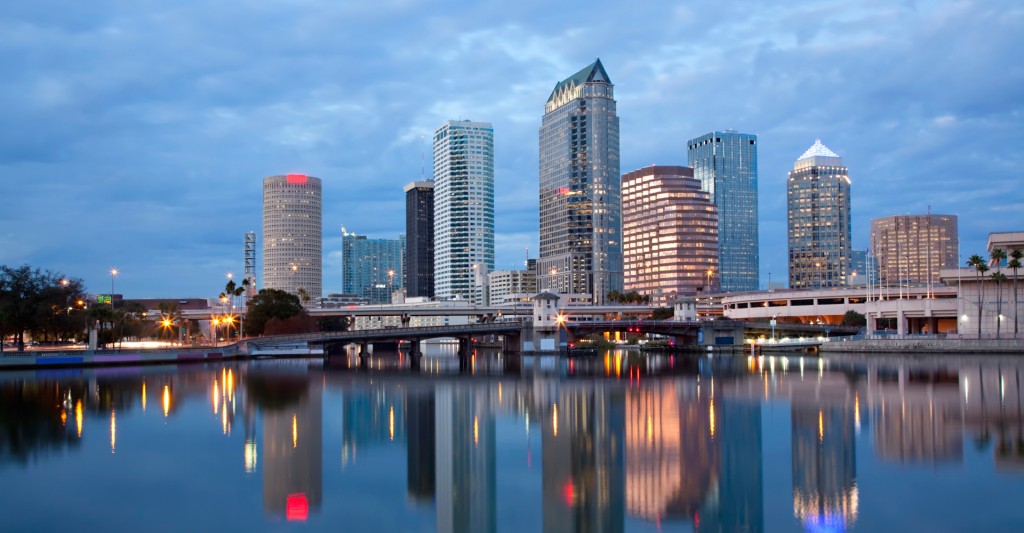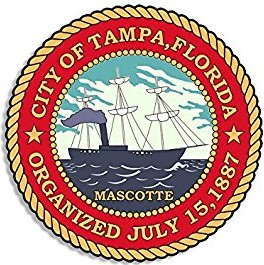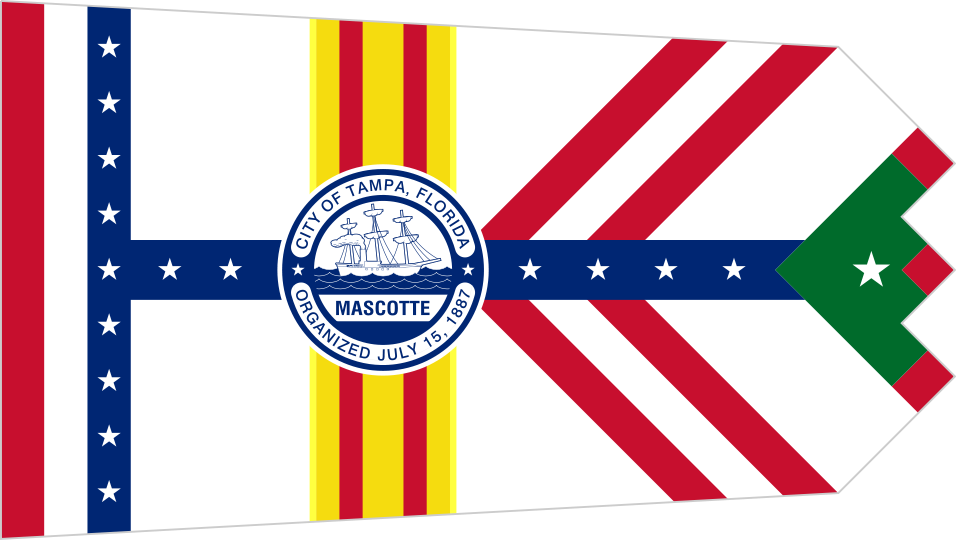City of Tampa

The City of Tampa is the largest city in Hillsborough County, is the county seat and is the third most populous city in Florida. It is located on the west coast of Florida, approximately 200 miles northwest of Miami, 180 southwest of Jacksonville, and 20 miles northeast of St. Petersburg. The population of the city represents approximately one-third of the total population of Hillsborough County. Tampa’s economy is founded on a diverse base that includes tourism, agriculture, construction, finance, health care, government, technology, and the port of Tampa. The city had a population of 335,709 at the 2010 census, and an estimated population of 377,165 in 2016. A 2012 estimate shows the Tampa Bay area population to have 4,310,524 people and a 2017 projection of 4,536,854 people.
The city is divided into many neighborhoods, many of which were towns and unincorporated communities annexed by the growing city. Generally, the city is divided into the following areas: Downtown Tampa, New Tampa, West Tampa, East Tampa, North Tampa, and South Tampa. Well-known neighborhoods include Ybor City, Forest Hills, Ballast Point, Sulphur Springs, Seminole Heights, Tampa Heights, Palma Ceia, Hyde Park, Davis Islands, Tampa Palms, College Hill, and non-residential areas of Gary and the Westshore Business District.
Tampa has three major professional sports teams. The NFL’s Tampa Bay Buccaneers and the NHL’s Tampa Bay Lightning, the Tampa Bay Rays of the MLB play across the bay in St. Petersburg. The Tampa Bay area has long been a site for Major League Baseball spring training teams. The New York Yankees conduct spring training in Tampa, and the Tampa Tarpons play there in the summer.
When to visit
Tampa has mild winters (Dec–Feb) and hot, rainy summers (Jun–Sep). Popular months for visitors are Dec–Jan, Mar–May and Jul. The city’s signature event is the Gasparilla Pirate Festival (Jan/Feb), featuring an elaborate mock pirate invasion from the sea and a raucous parade downtown. In Feb, the Florida State Fair attracts families with carnival rides and attractions, livestock exhibitions and food stalls.
History
 Settled 1823. Incorporated Village on January 18, 1849. Incorporated Town on September 10, 1853 and August 11, 1873. City Incorporated on December 15, 1855. Original city charter revoked by Florida Legislature on October 4, 1869. City re-incorporated in July 15, 1887.
Settled 1823. Incorporated Village on January 18, 1849. Incorporated Town on September 10, 1853 and August 11, 1873. City Incorporated on December 15, 1855. Original city charter revoked by Florida Legislature on October 4, 1869. City re-incorporated in July 15, 1887.
Archaeological evidence indicates the shores of Tampa Bay were inhabited by indigenous peoples for thousands of years. The Safety Harbor culture developed in the area around the year 1000 AD, and the descendant Tocobaga and Pohoy chiefdoms were living in or near the current city limits of Tampa when the area was first visited by Spanish explorers in the 16th century. Interactions between native peoples and the Spanish were brief and often violent, and although the newcomers did not stay for long, they introduced European diseases which brought the collapse of native societies across the Florida peninsula over the ensuing decades. Although Spain claimed all of Florida and beyond as part of New Spain, it did not found a colony on the west coast. After the disappearance of the indigenous populations, there were no permanent settlements in the Tampa Bay area until after the United States acquired Florida from Spain in 1821.
In 1824, the United States Army established a frontier outpost called Fort Brooke at the mouth of the Hillsborough River, near the site of today’s Tampa Convention Center downtown. The first civilian residents were pioneer ranchers and farmers who settled near the fort for protection from the nearby Seminole population.
The town grew slowly, and had become a minor shipping port for cattle and citrus by the time of the United States Civil War. Tampa Bay was blockaded by the United States Navy during the war, and Tampa fell into a long period of economic stagnation that continued long after the war ended.
The situation finally improved in the 1880s, when the first railroad links, the discovery of phosphate, and the arrival of the cigar industry jump-started its development, helping Tampa to grow from an isolated village with less than 800 residents in 1880 to a bustling city of over 30,000 by the early 1900s.
When the pioneer community living near the US Army outpost of Fort Brooke was incorporated in 1849, it was called “Tampa Town”, and the name was shortened to simply “Tampa” in 1855. The etymology of the name is unclear. The word “Tampa” may have meant “sticks of fire” in the language of the Calusa, a Native American tribe that once lived south of today’s Tampa Bay. This might be a reference to the many lightning strikes that the area receives during the summer months. Other historians claim the name means “the place to gather sticks”.
The first iteration of the name “Tampa” first appears in the memoirs of Hernando de Escalante Fontaneda (1575), who had spent 17 years as a Calusa captive and traveled through much of peninsular Florida. He spelled it “Tanpa” and describes it as an important Calusa town on the west coast. While “Tanpa” may be the basis for the modern name, archaeologist Jerald Milanich states that the Calusa village of Tanpa was on the shores of Charlotte Harbor, which is about 65 miles south of Tampa Bay. A later Spanish expedition did not notice the mouth of Charlotte Harbor while sailing north along the west coast of Florida and assumed that the current Tampa Bay was the bay they sought, thus accidentally transferring the name on Spanish navigational charts. Tampa Bay was labeled Bahía de Espíritu Santo (Bay of the Holy Spirit) in the earliest Spanish maps of Florida, but became known as Bahía Tampa (Tampa Bay) as early as 1695.
Not much is known about the cultures who called the Tampa Bay area home before European contact. When Spanish explorers arrived in the 1520s, they found Tocobaga villages around the northern half of Tampa Bay and Calusa villages along the southern portion of the bay.
Expeditions led by Pánfilo de Narváez and Hernando de Soto landed near Tampa, but neither conquistador stayed long. The native inhabitants repulsed any Spanish attempt to establish a permanent settlement or convert them to Catholicism. The newcomers brought with them infectious diseases, resulting in a total collapse of the native cultures of Florida. The Tampa area was depopulated and ignored for more than 200 years.
In the mid-18th century, events in American colonies drove the Seminole people into northern Florida. During this period, the Tampa area had only a handful of residents: Cuban and Native American fishermen. They lived in a small village at the mouth of Spanishtown Creek on Tampa Bay, in today’s Hyde Park neighborhood along Bayshore Boulevard.
After purchasing Florida from Spain in 1821, the United States built forts and trading posts in the new territory. Fort Brooke was established in January 1824 at the mouth of the Hillsborough River on Tampa Bay, in Downtown Tampa. Tampa was initially an isolated frontier outpost. The sparse civilian population practically abandoned the area during the Second Seminole War from 1835 to 1842, after which the Seminoles were forced out and many settlers returned.
Florida became the 27th state in 1845. On January 18, 1849, Tampa was officially incorporated as the “Village of Tampa”. It was home to 185 civilians, or 974 total residents including military personnel, in 1850. Tampa was reincorporated as a town on December 15, 1855.
During the Civil War, Florida seceded along with most of the southern states to form the Confederate States of America, and Fort Brooke was manned by Confederate troops. Martial law was declared in Tampa in January 1862, and Tampa’s city government ceased to operate for the duration of the war. In 1861, the Union Navy set up a blockade around many southern ports to cut off the Confederacy, and several ships were stationed near the mouth of Tampa Bay. The Battle of Fort Brooke on October 16 and the Battle of Ballast Point on October 18, 1863, damaged the Confederates, The Civil War ended in April 1865 with a Confederate defeat. In May 1865, federal troops arrived in Tampa to occupy the fort and the town as part of Reconstruction. They remained until August 1869.
Tampa was a fishing village with very few people and industry. Tampa’s chronic yellow fever epidemics, borne by mosquitoes from the swampland, were widespread during the late 1860s and 1870s, and many residents left. In 1869, residents voted to abolish the city of Tampa government. The population of “Tampa Town” was below 800 by 1870, and had fallen further by 1880. Fort Brooke was decommissioned in 1883, and except for two cannons displayed on the University of Tampa campus, all traces of the fort are gone.
In the mid-1880s, Tampa’s fortunes took several sudden turns for the better. First, phosphate was discovered in the Bone Valley region southeast of Tampa in 1883. The mineral, vital for the production of fertilizers and other products, was soon being shipped out from the Port of Tampa in great volume. Tampa is still a major phosphate exporter.
The discovery of phosphate, the arrival of the railroad and the founding of Ybor City and West Tampa all in the mid-1880s were crucial to Tampa’s development. The village of Tampa became a boomtown almost overnight, and had grown into one of the largest cities in Florida by 1900. The South Florida Railroad reached Tampa and its port in late 1883, finally connecting the small town to the nation’s railroad system. The railroad made it much easier to get goods in and out of the Tampa Bay area. Phosphate and commercial fishing exports could be sent north by rail, and many new products were brought into the Tampa market, along with the first tourists.
The new railroad link enabled another important industry to come to Tampa. In 1885, Tampa Board of Trade enticed Vicente Martinez Ybor to move his cigar manufacturing operations to Tampa from Key West. Proximity to Cuba made importation of “clear Havana tobacco” easy by sea, and the railroad made shipment of finished cigars to the rest of the US market easy by land.
Since Tampa was still a small town at the time (population less than 5,000), Ybor built hundreds of small houses around his factory to accommodate the immediate influx of mainly Cuban and Spanish cigar workers. Ybor City’s factories rolled their first cigars in 1886, and many different cigar manufacturers moved their operations to town in ensuing years. Many Italian and a few eastern European Jewish immigrants arrived starting in the late 1880s, opening businesses and shops that catered to cigar workers. By 1900, over 10,000 immigrants had moved to the neighborhood. Several thousand more Cuban immigrants built West Tampa, another cigar-centric suburb founded a few years later. Between them, two “Latin” communities combined to exponentially expand Tampa’s population, economic base, and tax revenues, as Tampa became the “Cigar Capital of the World”. During the first few decades of the 20th century, the cigar-making industry was the backbone of Tampa’s economy. The factories in Ybor City and West Tampa made an enormous number of cigars—in the peak year of 1929, over 500,000,000 cigars were hand rolled in the city.
Tampa grew considerably as a result of World War II. Prior to the United States’ involvement in the conflict, construction began on MacDill Field, which served as a main base for Army Air Corps and later Army Air Forces operations just before and during World War II, with multiple auxiliary airfields around the Tampa Bay area and surrounding counties. At the end of the war, MacDill remained as an active military installation, while the auxiliary fields reverted to civilian control. Two of these auxiliary fields would later become the present-day Tampa International Airport and St. Pete–Clearwater International Airport. With the establishment of an independent U.S. Air Force in 1947, MacDill Field became MacDill Air Force Base.
During the 1950s and 1960s Tampa saw record-setting population growth that has not been seen since. This amazing growth spurred major expansion of the city’s highways and bridges, bringing thousands into the city and creating opportunities for Tampa business owners who welcomed tourists and new citizens alike into their neighborhoods. It was during this time period in the city’s history that two of the most popular tourist attractions in the area were developed – Busch Gardens and Lowry Park. Many of the well-known institutions that play an important role in the economic development of the city were established during this time period.
The University of South Florida was established in North Tampa in 1956 and opened for students in September 1960. The school spurred the construction of several residential and commercial developments in the previously agriculture-dominated area around the new campus. Overall, Tampa continued to expand away from the city center during the 1960s as new hospitals, schools, churches and subdivisions all began appearing to accommodate the growth. Many business offices began moving away from the traditional downtown office building into more convenient neighborhood office plazas.
In 1970, the U.S. Census Bureau reported city’s population as 80.0% white and 19.7% black.
Four attempts have been made to consolidate the municipal government of the city of Tampa with the county government of Hillsborough County (1967, 1970, 1971, and 1972), all of which failed at the ballot box; the greatest loss was the most recent attempt in 1972, with the final tally being 33,160 (31%) in favor and 73,568 (69%) against the proposed charter.
The biggest recent growth in the city was the development of New Tampa, which started in 1988 when the city annexed a mostly rural area of 24 square miles (62 km2) between I-275 and I-75.
East Tampa, historically a mostly black community, was the scene of several race riots during and for some time after the period of racial segregation, mainly due to problems between residents and the Tampa Police Department.

Quick Links
Sports
Government
Things To Do
- Lowry Park Zoo
- Florida Aquarium
- Adventure Island
- Busch Gardens
- Straz Center for the Performing Arts
- Tampa Bay Convention & Visitors Bureau
Transportation
Service Providers
